1.
CENTRAL/ WEST AFRICA
Log prices ease for Europe but firm for Asia
Log prices for the Asian market remained firm in early September, buoyed by the restricted
global supply situation. However, iroko was out of favour with European buyers and prices
for all grades dropped back €15 per m3, but were unchanged for Asian destinations.
Moabi LM and B grades also fell for Europe but held firm for Asian buyers. Padouk prices
held onto recent gains as buyers
scrambled to obtain continuing supply. Sapele prices also remained strong as supply was
reported to be short throughout the region, a far cry from the low prices last year caused
by the excessive volumes that flooded the market.
Demand for bubinga and bilinga was robust, reflecting the steady gains over the past few
months. The increasing interest of US buyers in replacing the scarce South American
mahogany sawnwood with khaya and other similar high quality red and red brown species,
such as sapele and utile, seems certain to stretch available supply and prop up prices
over the coming months.
Rains slow down logging and transportation
Rains were heavy in north of the equator, slowing down logging and transportation in
Cameroon, though mills reported having sufficient logs for current needs. The end of the
dry season in Gabon has been followed by rains in the coastal areas, which have not so far
affected the upcountry operators seriously.
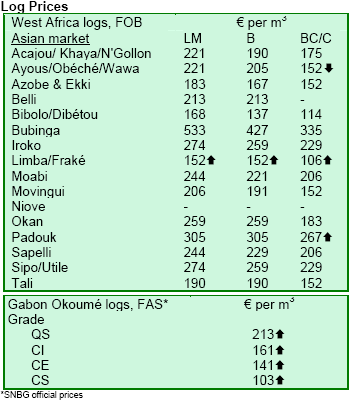
Sawnwood demand boosts governmental policies
The increased demand for sawn lumber has boosted governmental policies in the region,
especially in Cameroon, aimed at pushing a swift transformation of exports from purely
logs to sawn lumber, processed and downstream products. China has been much more active in
the sawn lumber market with uptake of large volumes of sawn okan and other hard species in
strips and squares at Douala and other ports ready for shipment. Meanwhile, mills reported
full order books for Asian and European destinations. Prices were firm and largely
unchanged, but increased interest from European buyers was likely to trigger the usual
upwards movements for species in limited supply.
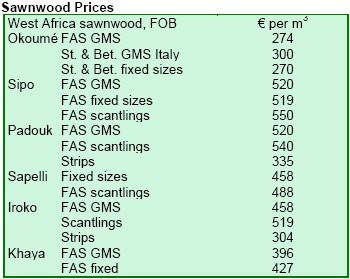
2.
GHANA
Ghana
inaugurates FC new Board
The president of the Republic of Ghana, J A Kufuor, has recently inaugurated the new Board
of the Forestry Commission (FC). Mr. Edward Nsenkyire was appointed as the Chair of the
Board and Chief Forest Conservator while Mr. John Otoo was selected as FC's acting Chief
Executive. President Kufuor urged the new board to provide the necessary leadership that
would bring about
the balance needed for sustainable development.

FC
registers all private forest plantations
The Forestry Commission (FC) of Ghana has embarked on a nation-wide exercise to register
all private forest plantations located outside forest reserves. The information will be
used to prepare a national database on all private plantations as a basis for planning
extension services as well as other incentives for private tree growers.

3. MALAYSIA
Timber product prices stabilize on eve of autumn
With the exception of plywood and other panel products, prices of most Malaysian timber
products were beginning to stabilize further. The market was starting to see marginal or
no price increments in stark contrast with the sharp increases of previous months. With
the commencement of autumn and winter seasons in Europe and the USA, the timber market was
expected to be quiet and uneventful part of the rest of the year.
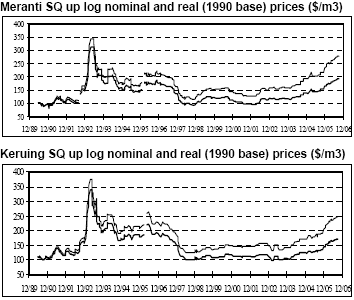
As shown above, meranti and keruing log prices keep reaching new 10- and 13-year highs,
respectively, exceeding 1997 Asian pre-crisis levels.
Monsoon herald firmer rubberwood prices
Prices of rubberwood products remained unchanged over the last two weeks, since prices for
natural rubber latex in Malaysia have declined recently from a high of 8.50 to 6.50
ringgit per kg. However, prices of rubberwood products are unlikely to decline in tandem
with natural rubber latex at the onset of the rainy monsoon season. The chart below shows
that rubberwood log domestic prices are at record highs since ITTO started to track this
species.
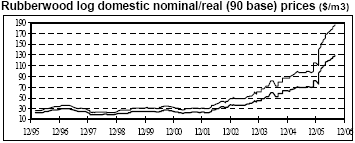
Chinese buyers heading for Malbex
Chinese interests in Malaysian timber products were in for another positive turn as the
Malaysian Trade Commission (Matrade), based in Beijing, will be leading a group of 29
buyers from China to the 23rd Malaysian International Building Exposition (Malbex), to be
held from 13 to 16 September 2006 at the Kuala Lumpur Convention Centre. The main
objective of Malbex is to provide opportunities for Chinese buyers in sourcing value-added
timber products and other building construction and building materials.
Sarawak promotes timber exports to Vietnam
Timber suppliers and exporters from Sarawak visited Hanoi in late August as part of a
six-day trade promotion tour of Vietnam. Led by the Sarawak Timber Industry Development
Corporation (STIDC), the tour was aimed at providing information on the latest
developments of the Sarawak timber industry, tap investment opportunities and further
enhance the trade relationship between both
countries. Vietnam was expected to be a potential market for Sarawak as the country
imports 80% of raw materials needed for the wood processing industry. The government
encouraged enterprises to boost lumber imports instead of over-exploiting domestic
forests.
Vietnam's wood processing industry has grown robustly in the past few years. Exports rose
from $1.2 billion in 2004 to $1.7 billion in 2005, according to the Ministry of
Agriculture and Rural Development. Sarawak timber exports to Vietnam constituted only $28
million in 2005, well below its potential, accounting for only 3% of Sarawak's timber
production volume and 2% of its timber
export value, according to STIDC.
Dubai faces soaring prices for building materials
Steep price hikes in recent months for core building materials, such as red meranti, MDF
whitewood and plywood were hitting building contractors and developers. Prices for these
materials climbed 20-30% during August and could further rise by another 20% over the next
two or three months, according to Dubai's Danube Building Materials FZCO. The recent price
increases followed a rise of 10-30% in prices for these materials earlier in the year,
bringing the overall price increase since January up to 40 to 45%. According to FZCO, the
price of red meranti rose from $550 to $700 per tonne and that of MDF from $215 to $270
per m3 in recent months. Whitewood prices jumped 20% to 1,100 dirham (dh) per m3 ($293 per
m3) while film-faced plywood prices rose from 90 dh to 125 dh per piece.
Booming building demand, short supply of these products in the Gulf and other markets and
higher freight charges were driving the price increases. Restrictions on log cutting by
countries like Malaysia, Indonesia and Myanmar, the appreciation of the euro and increased
local demand had also pushed prices up. Prices of steel rebar, a commodity-grade steel
used to reinforce concrete in
highway and building structures, were also reported to have gained around 36% in the first
half of the year in the UAE. FZCO said volatility of commodity prices in the world markets
was making sourcing materials difficult.
Glulam enjoys expanding market in Asia Pacific
With the growing interest in the use of renewable resources, the demand for wood as a
structural material was increasing. Engineered wood products (EWPs) such as glulam were
also being used in structures, according to Dr. Jegatheswaran Ratnasingam in an FDM Asia
article. Glulam is an engineered stress-rated product created by adhesively bonding
together individual pieces of lumber
with thickness of 50mm or less. It can be shaped into forms ranging from straight beams to
complex curved members. Glulam is used typically for headers, girders, purlins, beams, and
arches and less frequently in outdoor applications such as bridges, marinas and
transmission structures.
Global glulam consumption registers healthy growth
In 2005, Europe was the largest market for glulam at 1.87 million m3, followed by the
Asia-Pacific region with 1.49 million m3 and North America with 0.9 million m3. In North
America there is greater acceptance for laminated veneer lumber (LVL), another EWP. Glulan
demand in Asia-Pacific is driven by Japan and China. Japan is both the largest consumer
and producer of EWPs in the region, with glulam accounting for almost 48% of the
consumption. Nearly one-third is imported from Indonesia, New Zealand, Malaysia and China.
Since 2002, Japan¡¯s glulam imports have risen almost 65%, with new supplies arriving
from Russia. The wood-frame construction sector accounts for almost 60% of the new housing
starts in Japan. The Japanese wood-frame sector has three sub-sectors: traditional post
and beam construction, light-frame construction and pre-fabricated
structures. Post and beam housing dominates the woodframe sector with a share of over 80%.
The post and beam sub-sector in the Japanese residential construction sector was estimated
to absorb around 86% of the imported glulam. The demand for glulam in China was estimated
to be in the range of 150,000 m3 and was expected to surpass the 500,000 m3 level within
the next few years.
Rosy prospects for glulam in coming years
Dr. Ratnasingam expected the demand growth for glulam to escalate as the supply of solid
wood products declines. Many engineered wood products, such as glulam, are made from
young, small diameter trees, making their production expandable. Moreover, some of the
EWPs provide a market for lower quality fiber (both species and diameter). Against this
backdrop, he added, the future outlook for glulam demand appeared promising.
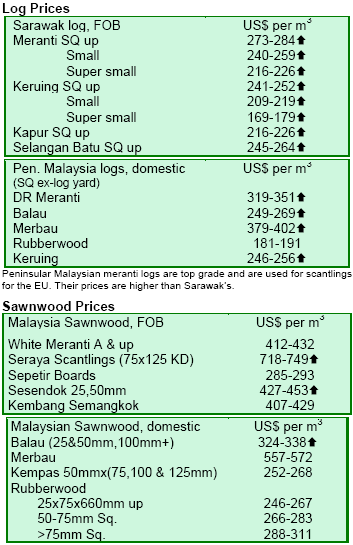
4. INDONESIA
Indonesia wary of US housing slowdown
The Indonesian timber market looked set to remain dormant for most of September and
perhaps for the rest of the year as the Indonesian government braced itself on news of a
US housing market slowdown cascading through the market. According to the IMF (see Report
from North America), the slowdown in the US housing market could be more severe than
expected, to the extent of hurting the US and global economy. However, some quarters were
hopeful that the US housing market would follow the markets in Australia and the UK, where
the slowdown was orderly.
The recent housing construction boom in the USA had boosted timber exports from Indonesia.
The Indonesian plywood and panel products industry, in particular, was the most vulnerable
to any slowdown in the US economy, especially in the west coast.
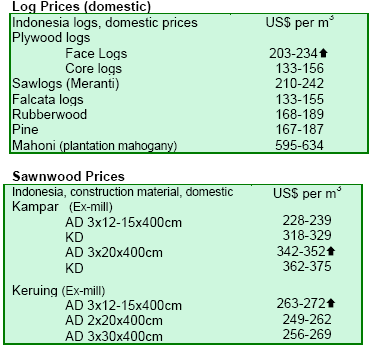
5.
MYANMAR
Demand and supply prop teak log prices up
The teak log market was strong with active buying and selling activities. Prices for teak
had peaked several times over the past decades, but the higher grades that were abundant
till the 1970s are very rare today. Even though grades are low, prices remain relatively
high. How long can this be sustained by the markets? Some analysts think that as long as
there is good demand for teak in
construction and furniture production, prices will remain stable.
The relatively high prices seen today are both demand-pulled and cost-pushed. Extraction
and timber transportation costs in Myanmar have increased significantly during the current
decade. Thus producers have to keep prices up while buyers cannot bring prices down.
Fears of over-heating in the teak log market
Prices for some teak grades have undergone some corrections in the past weeks. Some
analysts blame it on the poor grades while others think the main reason was the
over-heated market. While there was a shortage of raw materials, some buyers were unable
to purchase at high prices and this may eventually bring prices down. Yet buyers keep
competing in bids for fresh supplies from
MTE. Some expect prices to climb because of demand. Some feel that the market was heated
leading to prices levelling off and even dipping. However, the trend is not likely to
change significantly in the short term.
Teak processing suffers from weak demand
The market of teak processing remained weak. Orders were not coming in large numbers. Some
analysts said it was because Myanmar wood industry has difficulty in guaranteeing a
regular supply of teak products due to the uncertainty in raw material supply.
India closes factories accused of smuggling
The pyinkado market remained weak while the gurjan (keruing) market was only steady for
fresh logs. Some analysts think that pyinkado demand might be facing the results of
previous price escalation. News about 1,000 factories being closed in India accused of
smuggling from Myanmar might have a positive effect on the dull hardwood market. However,
no noticeable changes had
taken place yet.

illegal loggers get long prison sentences in Myanmar
A township level court in Chin state, western Myanmar, sentenced 20 Indian nationals, who
were arrested in May for illegal logging, to over 10 years each in prison. One of the
detainees charged with poaching was sentenced to 15 years while the other 19 were
sentenced to 12 years for
illegal logging.
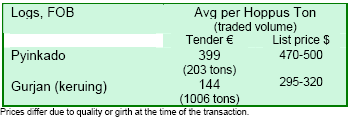
6.
PAPUA NEW
GUINEA
PNG log exports surge on strong Asian demand
Log exports from PNG surged to 216,781 m3 in July 2006. Total log exports (excluding
plantation) amounted to 2,51 million m3 in the year to July 2006. Saw/veneer grades
accounted for 85% of the total. Main log export species were taun, malas, bintangor and
terminalia. China took 80% of all log exports, followed by Japan (8%), Vietnam (5.4%) and
Korea (3.5%). Of the saw/veneer log grades,
China imported 89%, Japan 5.7%, Korea 2.2% and Vietnam 1.1%. For plantation species,
kamarere remained the main export species primarily to the markets of Vietnam, Japan,
China and Korea.
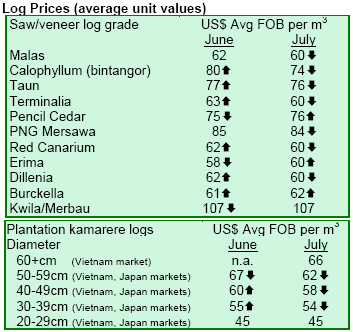
7. BRAZIL
Processed
products offset declining Par¡§¢ exports
Wood exports from Par¡§¢ State declined 12.9% to 545.7 million kg in Jan-Jul 2006 but
rose slightly 3.3% to $338.7 million, compared with the same period last year. Profiled
wood, such as floors and decking, was the main exported product category (43.7% of the
export value), overtaking sawnwood. This category also showed the fastest export growth in
the period. Export volume of tools and broom handles as well as wooden frames also showed
fast growth. Exports of plywood and veneered panels continued to decline and lose
competitiveness in the period due to the strengthening of the real against the US dollar.
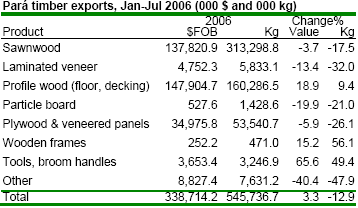
Brazil
launches online tracking system
As announced earlier (see TTM 10:18 and 11:8), Brazil has launched an online lumber
tracking system on 1 September intended to help authorities to crack down on illegal
logging in the Amazon rainforests. The system replaces the paper-based method of log
transport permits. Since June, police have arrested personnel accused of falsifying
logging permits in exchange for bribes. Under
the new system, loggers will register online their wood shipments rather than at local
Ibama's offices.
Some critics said that since Ibama agents would need internet access during inspections,
it would be difficult to verify whether the new certificates are valid. Moreover, wireless
internet is not widespread in the Amazon region and not all agents have laptops.
Rising domestic prices boost imports of MDF
The growing domestic demand for MDF has pushed prices up to 20% in the Brazilian market in
2006. MDF has been substituting particleboard and plywood in the manufacturing of wooden
furniture. According to the Brazilian Association of the Wood Panel Industry (ABIPA), MDF
production is expected to grow 20% to 1.68 million m³ this year.
In the first semester of 2006, the wood panel producers had raised MDF prices by 6-11% to
600 real per m³ (excluding taxes). The recent MDF price increase had hit the furniture
industry which absorbed 80% of the domestic production, forcing price adjustments of
around 9% in September 2006. Furniture companies were cornered by falling exports and
reduced domestic market. To face
growing production costs, some furniture companies were importing MDF from Argentina (see
TTM 11:16), which was 9-12% cheaper.
Brazil imported 100,000 m³ of MDF in the first semester of 2006, up 12% from the same
period last year. MDF imports were forecast to reach 180,000 m³ in 2007, up 20% from
2005. According to furniture companies, the demand for MDF had also being propped up by
moulding and wood frame companies. Some consumers felt that delays in MDF delivery exerted
pressure on prices, despite
that the top five MDF Brazilian producers had an installed capacity of 1.76 million m³ a
year. Production of MDF in Brazil is base on log and wood residues from planted forests
and is concentrated in the South and Southeast regions of the country.
Falling export revenues calls for new strategies
The furniture sector experienced an accumulated 10.4% fall in export revenues in the
Jan-Jul 2006 period, with exports amounting to $524.4 million. Exports revenues had fallen
4% in 2005 and the Brazilian Association of Furniture Companies (Abimovel) forecast an
additional fall of up to 5% in 2006. Abimovel said that, in the best case, 2006 exports
would be around 2005 levels.
According to some experts, improving Brazilian furniture exports would require opening the
sector to foreign capital. Some examples include investment from pension funds and other
mechanisms from consuming countries such as the USA where 38% of the Brazilian furniture
exports were sold. According to the experts, the participation of these investors in the
sector would lower the production costs of Brazilian export furniture by at least 20%,
making the country as competitive as other major worldwide players such as China.
Other experts have suggested that Brazil should capitalise the comparative advantage of
utilizing its wooden raw material and focus more on processed products rather than on
semi-processed and lower added-value products. They have also suggested manufacturing
companies to create market intelligence units in retail sales and increase training in
furniture production, sales and product
promotion.
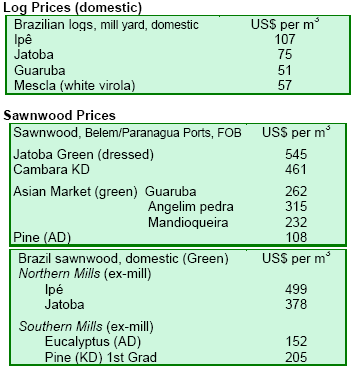
8.
PERU

9. BOLIVIA
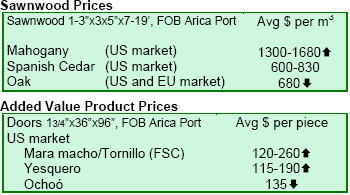
10. Guatemala

11. Guyana
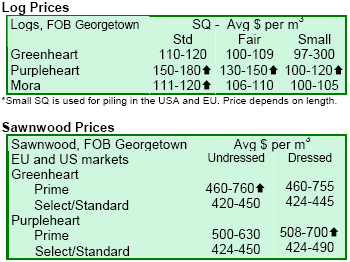
|